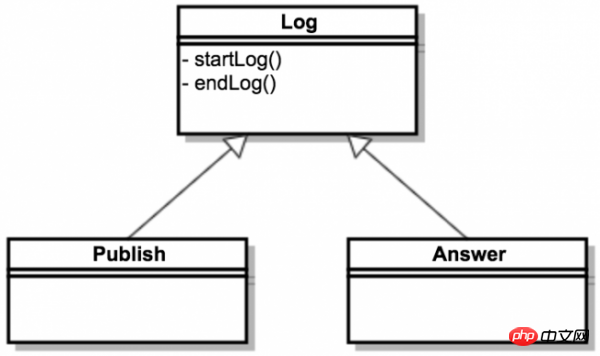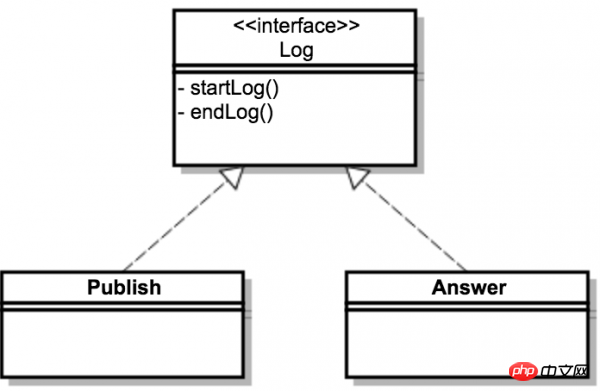Detailed explanation and application of Trait in php
1. Inheritance VS Polymorphism VS Trait
There are now two classes: Publish.php and Answer.php. To add LOG function to it, record the actions inside the class. There are several options:
Inherit polymorphic Trait 1.1. Inherit
as shown in the figure:

code The structure is as follows:
// Log.php
You can see that inheritance indeed meets the requirements. But this violates the object-oriented principle. The relationship between operations such as Publish and Answer and Log is not the relationship between the subclass and the parent class. So it is not recommended to use it this way.
1.2. Polymorphism
As shown:

Implementation code:
// Log.php
The logging operations should be the same, so the logging implementation in the Publish and Answer actions is also the same. Obviously, this violates the DRY (Don’t Repeat Yourself) principle. Therefore, it is not recommended to implement it this way.
1.3. Trait
As shown:

The implementation code is as follows:
// Log.php startLog(); $publish->endLog(); // Answer.php startLog(); $answer->endLog();
As you can see, we have achieved the code without increasing the complexity of the code. Reuse.
1.4. Conclusion
Although the inheritance method can also solve the problem, its idea violates the object-oriented principle and seems very crude; the polymorphic method is also feasible, but it is not in line with the software development process. The DRY principle increases maintenance costs. The Trait method avoids the above shortcomings and achieves code reuse relatively elegantly.
2. The scope of Trait
After understanding the benefits of Trait, we also need to understand the rules in its implementation. First, let’s talk about scope. This is easier to prove. The implementation code is as follows:
publicF(); $this->protectF(); $ this->privateF(); } } $publish = new Publish(); $publish->doPublish();
The output result of executing the above code is as follows:
public function protected function private function
It can be found that the scope of Trait is visible inside the Trait class that references it. It can be understood that the use keyword copies the implementation code of the Trait into the class that references the Trait.
3. Priority of attributes in Trait
When it comes to priority, there must be a reference object for comparison. The reference object here refers to the Trait class and its parent class.
Use the following code to prove the priority of attributes in the Trait application:
publicF(); $this- >protectF(); } } $publish = new Publish(); $publish->doPublish();
The output of the above code is as follows:
Publish::publicF public function Log::protectF protected function
Through the above example, the priority in Trait application can be summarized as follows:
Members from the current class override the trait's method and the trait overrides the inherited one. Method
The priority of class members is: Current class>Trait>Parent class
4. Insteadof and As keywords
In one class, multiple Traits can be referenced , as follows:
startLog(); $this-> parameterCheck($para); $this->endLog(); } }
Through the above method, we can reference multiple Traits in a class. When referencing multiple Traits, it is easy to cause problems. The most common problem is what to do if there are properties or methods with the same name in two Traits? At this time, you need to use the keywords Insteadof and as .Please see the following implementation code:
startLog(); $this->parameterCheck('params'); $this->csl(); } } $publish = new Publish(); $publish->doPublish();
Execute the above code, the output result is as follows:
Log: :startLog public function Check::parameterCheck parameter checkparams Check::startLog public function
Just like the literal meaning, the insteadof keyword replaces the latter with the former, and the as keyword gives an alias to the replaced method. .
When referencing Trait, the use keyword is used, and the use keyword is also used to refer to the namespace. The difference between the two is that when referencing Trait, it is used inside the class.

Hot AI Tools

Undresser.AI Undress
AI-powered app for creating realistic nude photos

AI Clothes Remover
Online AI tool for removing clothes from photos.

Undress AI Tool
Undress images for free

Clothoff.io
AI clothes remover

Video Face Swap
Swap faces in any video effortlessly with our completely free AI face swap tool!

Hot Article

Hot Tools

Notepad++7.3.1
Easy-to-use and free code editor

SublimeText3 Chinese version
Chinese version, very easy to use

Zend Studio 13.0.1
Powerful PHP integrated development environment

Dreamweaver CS6
Visual web development tools

SublimeText3 Mac version
God-level code editing software (SublimeText3)

Hot Topics
 1387
1387
 52
52
 PHP 8.4 Installation and Upgrade guide for Ubuntu and Debian
Dec 24, 2024 pm 04:42 PM
PHP 8.4 Installation and Upgrade guide for Ubuntu and Debian
Dec 24, 2024 pm 04:42 PM
PHP 8.4 brings several new features, security improvements, and performance improvements with healthy amounts of feature deprecations and removals. This guide explains how to install PHP 8.4 or upgrade to PHP 8.4 on Ubuntu, Debian, or their derivati
 7 PHP Functions I Regret I Didn't Know Before
Nov 13, 2024 am 09:42 AM
7 PHP Functions I Regret I Didn't Know Before
Nov 13, 2024 am 09:42 AM
If you are an experienced PHP developer, you might have the feeling that you’ve been there and done that already.You have developed a significant number of applications, debugged millions of lines of code, and tweaked a bunch of scripts to achieve op
 How To Set Up Visual Studio Code (VS Code) for PHP Development
Dec 20, 2024 am 11:31 AM
How To Set Up Visual Studio Code (VS Code) for PHP Development
Dec 20, 2024 am 11:31 AM
Visual Studio Code, also known as VS Code, is a free source code editor — or integrated development environment (IDE) — available for all major operating systems. With a large collection of extensions for many programming languages, VS Code can be c
 Explain JSON Web Tokens (JWT) and their use case in PHP APIs.
Apr 05, 2025 am 12:04 AM
Explain JSON Web Tokens (JWT) and their use case in PHP APIs.
Apr 05, 2025 am 12:04 AM
JWT is an open standard based on JSON, used to securely transmit information between parties, mainly for identity authentication and information exchange. 1. JWT consists of three parts: Header, Payload and Signature. 2. The working principle of JWT includes three steps: generating JWT, verifying JWT and parsing Payload. 3. When using JWT for authentication in PHP, JWT can be generated and verified, and user role and permission information can be included in advanced usage. 4. Common errors include signature verification failure, token expiration, and payload oversized. Debugging skills include using debugging tools and logging. 5. Performance optimization and best practices include using appropriate signature algorithms, setting validity periods reasonably,
 How do you parse and process HTML/XML in PHP?
Feb 07, 2025 am 11:57 AM
How do you parse and process HTML/XML in PHP?
Feb 07, 2025 am 11:57 AM
This tutorial demonstrates how to efficiently process XML documents using PHP. XML (eXtensible Markup Language) is a versatile text-based markup language designed for both human readability and machine parsing. It's commonly used for data storage an
 PHP Program to Count Vowels in a String
Feb 07, 2025 pm 12:12 PM
PHP Program to Count Vowels in a String
Feb 07, 2025 pm 12:12 PM
A string is a sequence of characters, including letters, numbers, and symbols. This tutorial will learn how to calculate the number of vowels in a given string in PHP using different methods. The vowels in English are a, e, i, o, u, and they can be uppercase or lowercase. What is a vowel? Vowels are alphabetic characters that represent a specific pronunciation. There are five vowels in English, including uppercase and lowercase: a, e, i, o, u Example 1 Input: String = "Tutorialspoint" Output: 6 explain The vowels in the string "Tutorialspoint" are u, o, i, a, o, i. There are 6 yuan in total
 Explain late static binding in PHP (static::).
Apr 03, 2025 am 12:04 AM
Explain late static binding in PHP (static::).
Apr 03, 2025 am 12:04 AM
Static binding (static::) implements late static binding (LSB) in PHP, allowing calling classes to be referenced in static contexts rather than defining classes. 1) The parsing process is performed at runtime, 2) Look up the call class in the inheritance relationship, 3) It may bring performance overhead.
 What are PHP magic methods (__construct, __destruct, __call, __get, __set, etc.) and provide use cases?
Apr 03, 2025 am 12:03 AM
What are PHP magic methods (__construct, __destruct, __call, __get, __set, etc.) and provide use cases?
Apr 03, 2025 am 12:03 AM
What are the magic methods of PHP? PHP's magic methods include: 1.\_\_construct, used to initialize objects; 2.\_\_destruct, used to clean up resources; 3.\_\_call, handle non-existent method calls; 4.\_\_get, implement dynamic attribute access; 5.\_\_set, implement dynamic attribute settings. These methods are automatically called in certain situations, improving code flexibility and efficiency.



